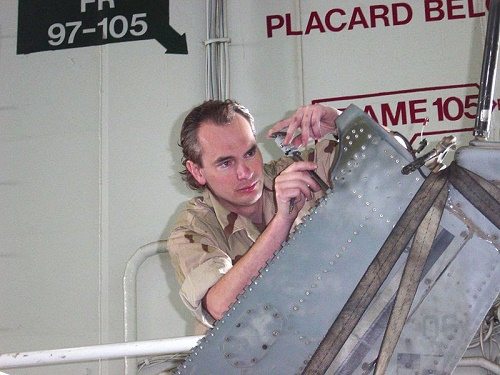If you’ve ever dreamed of designing vessels such as airplanes, spaceships or boats, you might have an interest in an engineering discipline such as aerospace or marine engineering. While there are some similarities between aerospace engineering and marine engineering degree programs and career paths, there are also important differences.
IMAGE SOURCE: Wikimedia Commons, public domain
Aerospace Engineering Education
To become an aerospace engineer, you need a minimum of a bachelor’s degree. Undergraduate degree programs in aerospace engineering are accredited by ABET (the Accreditation Board for Engineering and Technology) and typically require four years of full-time study to complete. Students in an aerospace engineering degree programs should expect to take courses in advanced mathematics, general concepts in engineering, mechanics, propulsion, structures, stability and control and aerodynamics, the United States Bureau of Labor Statistics (BLS) reported.
An aerospace engineering education consists of classroom lectures, laboratory science work and fieldwork. In fact, hands-on experience applying the principles of engineering and mathematics is so important for aspiring engineers that internships and cooperative programs are often encouraged or even required. Engineers solve problems – in aerospace engineering, those problems revolve around designing, building and maintaining aircraft and spacecraft – and to do that, they need to know both the theory of science, math and engineering and how to apply it.
A bachelor’s degree is the minimum education you will need to work as an aerospace engineer, according to NASA. However, some engineers benefit from having a more advanced degree, particularly if they want to work at a university or a research and development position. Typically, earning a master’s degree in aerospace engineering takes two years and a doctoral degree takes an additional two to four years, NASA reported. If you know before you even start college that you will want to have a graduate degree, you can look for an engineering school that offers an accelerated 5-year program culminating in a bachelor’s degree and a master’s degree.
While some aerospace engineers go on to earn their Professional Engineering (PE) license, licensure is less common in this discipline of engineering than in many other branches.
Marine Engineering Curriculum
Like aerospace engineering programs, bachelor’s degrees in marine engineering require four years of study and are accredited by ABET. There is even some similarity in terms of coursework, with both programs requiring studies in advanced math and science and general engineering principles.
However, there are also significant differences. Marine engineering degree programs are more likely to be found at maritime academies like the United States Merchant Marine Academy or at state maritime academies than at traditional universities and engineering schools. Coursework for aspiring marine engineers includes specialized studies in ship hull strength, naval science, fluid mechanics, sea safety and mechanics of materials. For students in a maritime academy, gaining hands-on experience doesn’t just meaning completing an internship with an engineering company, but rather spending summers at sea gaining onboard operating experience, the BLS reported.
Maritime academies offer naval architect degrees as well as marine engineering degrees. You can also become a marine engineer with a mechanical or electrical engineering background.
Jobs for Aerospace and Marine Engineers
The biggest difference between aerospace and marine engineers is that one designs and builds airplanes and spaceships, while the other designs and builds boats. There are also differences in work environments, earning potential and job outlook.
Aerospace engineers design aerospace vessels and technology and oversee the manufacture and testing of their creations. They work with and guidance and control systems, propulsion and combustion, flight and celestial mechanics, robotics, instrumentation and communication and other concepts and applications needed for safe and effective flight. Aerospace engineers design and build everything from commercial airplanes to military missiles, though individuals working in this field often specialize in one type of aircraft or spacecraft. Within the field of aerospace engineering, engineers typically choose to work in either aeronautical engineering, which is the designing of aircraft that flies within the atmosphere, or astronautical engineering, the creation of spacecraft that travel beyond earth’s atmosphere, the BLS reported. While an aerospace engineering education is specialized, there are a number of jobs you can get with an aerospace engineering degree, ranging from astronaut to data processing manager.
More than one-third of aerospace engineers work in the specialized industry of aerospace product and parts manufacturing, according to the BLS. Others work in general engineering services, federal government entities, navigational and control instruments manufacturing and scientific research and development. Even among engineering occupations, aerospace engineers earn high salaries, with a median wage of $113,030 per year. The BLS expects job opportunities for aerospace engineers to increase by 6 percent, or 4,200 jobs, in a decade.
Marine engineers design and maintain the equipment, machinery and internal systems of a ship. This work includes drafting layouts, drawings and schematics of a vessel’s electrical, steering, propulsion and refrigeration systems, the BLS reported. Whether working on a submarine, an aircraft carrier or a sailboat, a marine engineer must install, test, troubleshoot, maintain and repair these systems to make sure they run safely, effectively and in compliance with legal regulations. Some marine engineers work onshore, in offices with regular work schedules, while others work at sea.
Generally speaking, marine engineers earn less than aerospace engineers – and closer to the $92,220 median wage for all engineering occupations – with a median salary of $90,970. Marine engineering opportunities are growing at a faster than average rate, with the BLS predicting a 12 percent rise in jobs, about 1,000 new jobs total, over a span of just 10 years.
There are about 69,600 aerospace engineers and 8,200 marine engineers and naval architects working in the United States.



